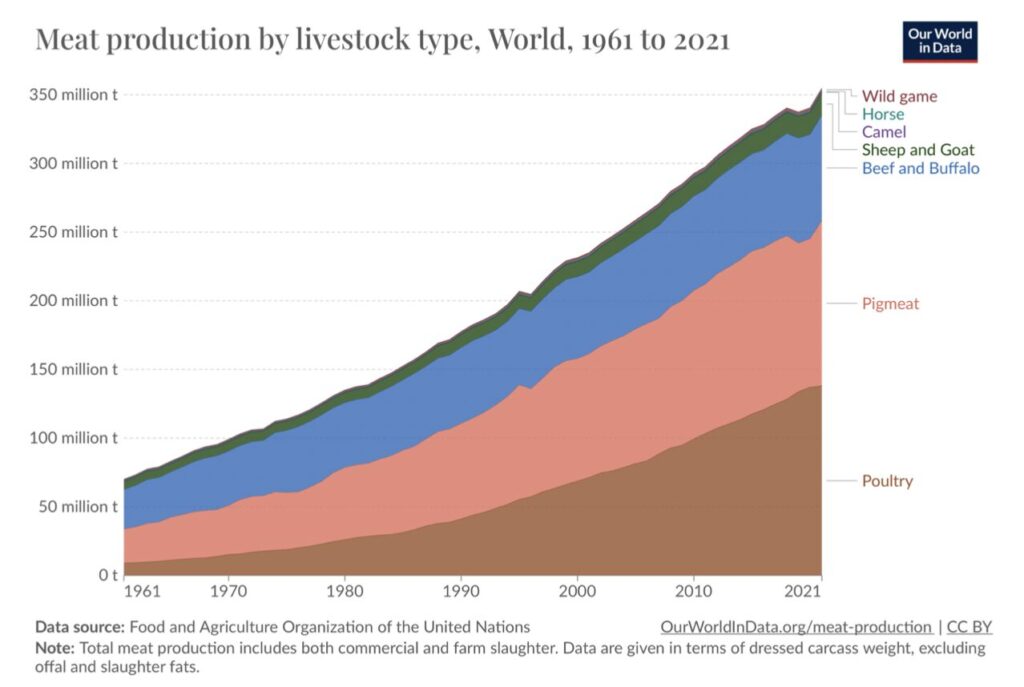Society’s Burden: How Taxpayers Carry the Crushing Costs of Livestock Production
5 Mins Read
From pollution and destruction to disease, the societal costs of livestock meat production are an incredible burden.
In 2020, the average American ate almost 280 pounds of meat, a figure which is very likely higher today. Many European and Latin American countries, not to mention Australia, New Zealand, Canada and Hong Kong also eat a large amount of animal meat. In most industrialized nations, animal proteins are at the center of the average person’s breakfast, lunch, and dinner plate. But what of the costs to our collective health and environment? This past December, the UN’s Food and Agriculture Organization (FAO) released a paper showing that our food systems, which we know to be based on animal proteins, externalizes $12.7 trillion in costs to society. That is an estimated 10% of global GDP.

Why does meat cost society so much?
There is no shortage of research linking excess meat consumption to chronic disease. Both the Journal of American Medicine (JAMA) and The National Library of Medicine show that regularly eating processed meats (bacon, sausage, deli slices, hot dogs) can cause heart disease. The World Health Organization qualifies processed meats as carcinogenic. Further, meat consumption is associated with rising levels of diabetes and obesity, as per the National Library of Medicine. All this illness costs the average taxpayer dearly: from debilitating personal illness to skyrocketing healthcare costs, not to mention severe environmental damage and considerable economic loss.
For example, a 2018 Milken Institute report suggested that the $1.1 trillion in U.S. healthcare costs for chronic diseases such as heart disease, cancer, diabetes, and obesity, as determined by the Center for Disease Control (CDC) is closer to $3.7 trillion when lost economic productivity is included. “This is equivalent to nearly 20 percent of the U.S. gross domestic product (GDP),” according to the report authors.
The FAO paper, published during the UN climate conference COP28 where sustainable and healthy food systems advancements were part of the main programming for the first time, noted that 73% of the $12.7 trillion cost to society was due to dietary pattern-induced productivity losses. In laypeople’s terms, we pay for our addiction to meat and other processed foods in more ways than at the grocery store.
Another societal cost of our meat-dependent food systems, perhaps not reflected in the $12.7 trillion, is our growing antibiotic resistance. Livestock animals are raised in cramped conditions where disease is rampant, and as such, require enormous amounts of antibiotics (over 70% of all antibiotics produced globally are used by the livestock industry). By consuming meat, we ingest those pharmaceuticals and develop a resistance to them.
Then, there are the environmental costs of our current food system, which the FAO report says “have an expected value corresponding to about 20 percent of total quantified hidden costs [$2.6T] caused by agrifood systems. Of these, more than half pertained to nitrogen emissions (mostly from runoff to surface waters and ammonia emissions to air). These were followed by the contributions of greenhouse gas emissions to climate change (30 percent), land-use change costs (14 percent), and water use (4 percent).”

Big Meat’s media tricks and the taxpayer burden
Through sophisticated media campaigns that follow the PR playbook of other polluting industries such as fossil fuels and tobacco, the livestock industry has convinced the average consumer that meat is healthy, a non-negotiable part of their cultural identity, and that they can’t live without it. Made aware of the significant costs and tax burden of livestock meat production detailed above, would most people choose differently?
Alas, the duping of society by the Big Meat lobby is quite seductive. Take, for example, a Big Mac. What appears to be one of the cheapest meals/foods available to a US consumer, is actually quite costly upon further review, in large part because of external costs (see above) and substantial meat production subsidies. According to a paper by the American Institute for Economic Research titled ‘The True Cost of a Hamburger’, “the United States federal government spends $38 billion every year subsidizing the meat and dairy industries. Research from 2015 shows this subsidization reduces the price of Big Macs from $13 to $5 and the price of a pound of hamburger meat from $30 to the $5 we see today.” Guess who pays for those subsidies in the end? That’s right! It’s us, the taxpayers. Not only are we incentivized to eat foods that make us sick and damage our environment, we are made to pay for it through taxes. Not only is this infuriating, it’s fiscally irresponsible. Not to mention it’s all in the service of a very below-average hamburger.
Food system innovation is the silver lining
There is a silver lining: investing in food system innovation. Per the U.N.E.P., despite livestock farming accounting for up to 18% of global greenhouse gas emissions, agrifood tech funding accounts for only 4% of global climate investments.
Public markets haven’t yet priced in the true negative costs of livestock meat production and the full positive potential of future food innovations. Now is the time to invest in what some might call a golden opportunity.
Where there is inefficiency, there is disruption through innovation. Markets thrive on this, and eventually, the great solutions rise to the top and there is mass adoption across society. Think of how the horse and buggy gave way to the automobile, the film developing industry gave way to digital imaging and the landline gave way to the cell phone. Today’s smart protein industry is alight with innovation that makes animal factories look like the dark-age torture relics they are.
Indeed, innovation for efficient protein diversification through plant-based foods, precision fermented proteins and cultivated meat is growing, and the benefits are many. With alternatives, society can meet the rising demand for protein from a growing, economically-mobile and urbanizing global population for a fraction of the health and environmental costs, as noted by the COP28 host nation the UAE’s Minister of the Environment Her Excellency Mariam Almheiri during the conference.
We can see the path to food systems change is already taking shape with pioneering startups hitting key milestones. Israel’s Aleph Farms, for example, has just received approval from the Israeli government for the public sale of cultivated beef. Their peers at Upside Foods and GOOD Meat received US regulatory approval for cultivated chicken in June of last year. In the past few weeks, several precision fermentation dairy companies have earned FDA self-affirmed GRAS status for their animal-free dairy proteins. Meanwhile, the plant-based industry continues to iterate and work to improve taste, ingredient quality and health credentials.
It’s never been a better time to invest in the future of food, and it’s never been more important. Soon, Governments across the world are waking up to this reality. In the meantime, you and your financial portfolio could potentially benefit from the market’s assymetry.





